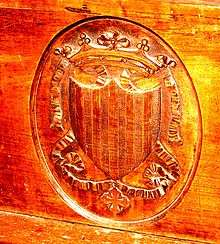Scarampi
Scarampi is the name of a prominent Ghibelline family of Asti and its environs in north-west Italy. They were bankers of the Casane astigiane first in Genoa and then in France and in Belgium. In 1337 Antonio Scarampi, in exchange for 115,000 florins, became feudatory of Bubbio, Monastero Bormida, Roccaverano, Cortemilia, Perletto, Cairo, Altare and other places of the Langhe. Oddone, Giacomo and Giovannone, three of the five sons of Antonio, each originated their own lineages. Notably, the lineages that are still present nowadays are: Scarampi del Cairo, Scarampi di Villanova and Scarampi di Pruney.

Historical figures with the name Scarampi include:
- Enrico Scarampi (died 1440), Bishop of Acqui, Bishop of Belluno-Feltre, and participant in the Council of Constance.
- Francesco Scarampi di Moncucco e Monale, Mayor of Turin in 1725
- Girolamo Scarampi, Bishop of Campagna from 1571 to 1584
- Giuseppe Maria Scarampi, Bishop of Vigevano from 1757 to 1801
- Lazzaro Scarampi, Bishop of Como from 1461 to 1466
- Ludovico Scarampi Mezzarota (1401–1465), doctor, condottiere and cardinal
- Luigi Scarampi del Cairo, Mayor of Turin in 1783
- Rolando Scarampi, from the branch of the family who were counts of Camino, and perhaps from Casale, was Bishop of Reggio Emilia from c.1336 to c.1339.[1][2][3]
- Pierfrancesco Scarampi (1596–1656) a Roman Catholic oratorian and Papal envoy to Confederate Ireland.
The name Scarampi is also used in the toponyms of various places which were fiefs of the family, including Montaldo Scarampi and San Giorgio Scarampi. Several castles are associated with the Scarampi family, including the Castle of Camino and Castle of Monforte d'Alba.
Notes
- This article was originally translated from its counterpart in the Italian Wikipedia.
- Giuseppe Cappelletti, Le chiese d'Italia della loro origine sino ai nostri giorni, 21 vols (Venice: Giuseppe Antonelli, 1844–70), XV: Chiese degli Stati Parmensi (1858), 398 and 385.
- Dizionario geografico, storico, statistico, commerciale degli stati di S.M. il re di Sardegna, ed. by Goffredo Casalis, 28 vols (Turin: G. Maspero, 1833–56) III (1836), 361.
- Cappelletti (p. 398) identifies his tenure of the bishopric as 1336–1339, Casalis as 1337–1340. Capalletti describes him as being Casalese (p.385): this is quite possible, but might also be explained by Camino being close to this more important centre.